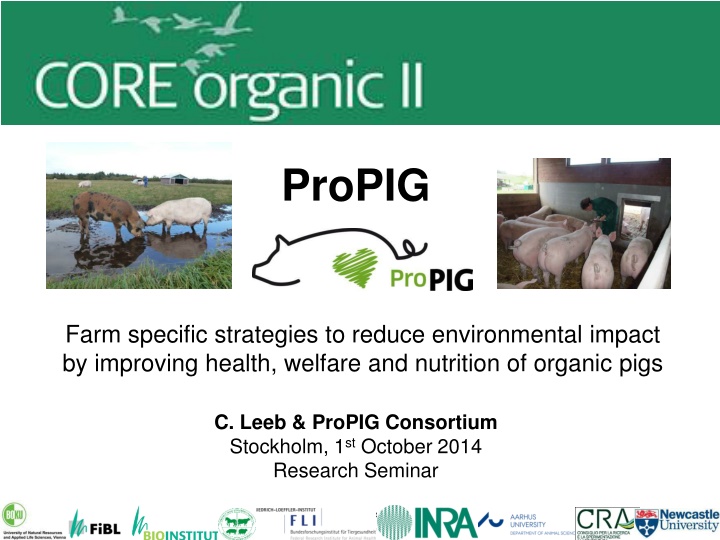
Strategies to Reduce Environmental Impact in Organic Pig Farming
Discover farm-specific strategies to improve the health, welfare, and nutrition of organic pigs, ultimately reducing environmental impact. Explore different pig husbandry systems, their environmental implications, and the implementation of preventative and therapeutic measures to enhance pig health and well-being. Join ProPIG in their quest to promote sustainable and eco-friendly pig farming practices.
Download Presentation

Please find below an Image/Link to download the presentation.
The content on the website is provided AS IS for your information and personal use only. It may not be sold, licensed, or shared on other websites without obtaining consent from the author. If you encounter any issues during the download, it is possible that the publisher has removed the file from their server.
You are allowed to download the files provided on this website for personal or commercial use, subject to the condition that they are used lawfully. All files are the property of their respective owners.
The content on the website is provided AS IS for your information and personal use only. It may not be sold, licensed, or shared on other websites without obtaining consent from the author.
E N D
Presentation Transcript
ProPIG Farm specific strategies to reduce environmental impact by improving health, welfare and nutrition of organic pigs C. Leeb & ProPIG Consortium Stockholm, 1stOctober 2014 Research Seminar ProPIG Christine Leeb CoreOrganic Research Seminar, Stockholm, 1st October 2014
Three Pig Husbandry Systems in Europe 75 farms in 8 countries To identify animal - environment interactions in three systems Hypothesis all systems are able to ensure good welfare and low environmental impact when well managed =? =? Outdoor Indoor with concrete outside run Partly outdoor ProPIG Christine Leeb CoreOrganic Research Seminar, Stockholm, 1st October 2014
Environment - Greenhouse gas emissions: CO2-eq in 3 Systems No statistical difference GHGE/ 1000kg slaughter pig (Live weight) Partly outdoor: Better than outdoor: Eutrophication potential (PO4-eq.) Better than indoor: Acidification (SO2- eq.) Partly (n=30) Indoor (n=24) Outdoor ProPIG Christine Leeb CoreOrganic Research Seminar, Stockholm, 1st October 2014 ProPIG Christine Leeb CoreOrganic Research Seminar, Stockholm, 1st October 2014 (n=10)
Farm specific strategies for improvement To develop and implement Farm specific strategies to: reduce environmental impacts by improving health, welfare, nutrition and management of organic pigs 3. Visit Assessment Farm plan Implementation of measures Weaners Visit 1 A099 4 / 70 A B C D E N groups/piglets % weaners ocular discharge % conjunctivitis % pens with resp. problems % pens with severe resp. problems goal: improve respiratory problems Preventative measures find reason take blood samples; adapt vaccination if necessary improve ventilation Therapy: mild cases without fever: herbal cough tea; otherwise Antibiotic 32.5 - 70 0 - 0 0 - 0 >70 - 82.5 >0 - 0 >0 - 33.3 >82.5 - 90 >0 - 0 >33.3 - 50 >90 - 98.3 >0 - 7.5 >50 - 80 >98.3 - 100 >7.5 - 40 >80 - 100 97,5 8,8 75,0 0 - 0 >0 - 0 >0 - 0 >0 - 0 >0 - 100 0,0 2. Visit Farm plan To disseminate knowledge to national advisory bodies and farmers 1. Visit Assessment ProPIG Christine Leeb CoreOrganic Research Seminar, Stockholm, 1st October 2014
Training & On Farm Improvement Training and Inter-Observer Agreement 3 Farm visits: 1. On farm data collection 2. Feedback to farmer as Farm plan incl. Goals and Measures 3. Repeat visit to measure effectiveness ProPIG Christine Leeb PigSurfer CoreOrganic Research Seminar, Stockholm, 1st October 2014
Analysis & Dissemination Booklet for Improvement ProPIG Christine Leeb CoreOrganic Research Seminar, Stockholm, 1st October 2014
